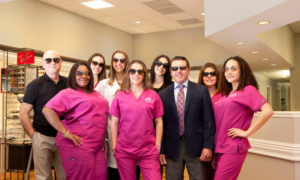By Nancy Rausman
Google your own practice.If you don’t come up near the top of the listings, you have a problem–but acouple of simple steps can fix that.
Manypatientsfind an eye doctor by searching onGoogle. If they are looking cold, they may limit their search to their immediatehome or work area. If they have been recommended an eye doctor, they also will search on Google–and here they have the same critical need: to easily find a doctor’s web site, andreadily be assuredthat the practice looks legitimate and appealing.
As simple as this seems, this is where many eyecare practices fall short. They fail to make themselves Search Engine Optimized (SEO).
When a patient has trouble finding a prospective doctor’s web site, they may become frustrated and give up or they may think less of the doctor–as if it is somehow the fault of the practice that the web site can not be easily found. “What kind of practice is this, anyway? I can’t even find it on Google.” To ensure your possible future patients don’t fall away before they make it inside your office, here areeasy fixes to boost your search engine optimization.
Search Engine Rankings Matter
Ninety percent of healthcare searches are done online. New patients are no longer using traditional methods such as phonebooks, ads and commercials to find an optometrist. They are using Google and, if you’re at the top, you get the patient, and you get the money. It’s plain and simple. The internet is replacing the yellow pages and you want consumers to be able to find you there–and in order to be there, you need SEO. If you ignore SEO, your competition will get way ahead of you and potential new patients will have a harder time finding your practice.
KEY GOALS WITH SEO
Quality: SEO shouldn’t be focused on obtaining specific numbers of traffic but rather on the quality of the traffic
ROI: You should derive a substantial return on investment) by the conversions (the number of people visiting the site that convert to paying customers).
You can set up Google Analytics on your site to track this.
SIMPLE SEO STEPS
Ifyou are in an area of greatcompetition, consider hiring an SEO expert. These experts conduct keyword research andformulate aback-linking strategy that targets diverse, high PageRank sites. But on your own you can boost your site ranking and visibility online.
The ease of such measures largely depends on how easy it is to make changes on your web site. EyeCarePro (and many other) web sites are built on content management systems that allow you to change your site as much as you want, as easily as using a word processor. If your site was built with HTML, you typically need to pay a company to make changes to the site.
 Use a Title Tag on Your Homepage
Use a Title Tag on Your Homepage
If you were only going to make one change to your site, the easiest / best change would be to set a good title tag on the home page of your web site. The title tag is how you name the individual pages on your web site. In the search results it shows up as the top, blue keyphrase above the description. Your title tag should be no longer than 69 characters and should include the main target keyword near the beginning of the phrase. Depending on how your web site is set up, this may require assistance from tech support or a web specialist.
ADVANCED SEO STEPS
Onsite SEO/Keyword Research
Keyword research and optimization are essential if you want the right traffic to find your practice web site. Using the Google Adwords Keyword Tool you can research the words and phrases that potential patients are using to find an optometry practice in your area. You should test phrases that involve both optometry and your location such as “Las Vegas optometrist” or “Eye Exam Detroit,” and when you find those that are the most popular, optimize your web site copy accordingly. Start with the first three highly used pages of the site which are the homepage, eye doctor page and eyecare services page.
It’s important to naturally incorporate these words into your content, including the heading of the page and the beginning of the first paragraph, avoiding what is known as “keyword stuffing,” which means “stuffing” keywords into the content whether or not the copy makes sense.
Optimizing metatags (in addition to the title tag mentioned above there are also description and keywords tags) is another onsite fix that can help. You want your tags to be the correct length (the length varies depending which kind of metatag you’re dealing with) and include the keywords for each page. Your description tag, which is the small description that shows under the title tag in the search results, should be enticing. It should make searchers want to click on your page over the other pages in the search results.
After these first three pages are optimized with keyword rich content and metatags you can gradually optimize additional pages of your site as you have time.
Update Often with Fresh, Unique Content
There is a saying in the SEO world that “Content is king.” The search engines value web sites that provide unique, relevant and up-to-date content. Check that all content (including photos) is current, from the contact information and address to staff to the news section (you don’t want a Closed for Christmas message up in August). Grammar and spelling should be carefully proofed and writing should be professional and relevant.
It’s good to update your web site with fresh content on a regular basis. The easiest way to do this is to have a news or blog section to which you add articles at least once a week. This may sound daunting but it doesn’t have to be. There are a broad range of easy topics you can cover such as an introduction to a new staff member, a sale or new product, an eyecare tip or a charity event the practice is sponsoring. The goal is for the site to always be up-to-date and for Google to see that you are making the effort to keep your site fresh and relevant.
Build Links
Linkbuilding, which means acquiring links to your site that include certain keywords, is one of the main components of SEO and one of the most time consuming. Backlinks are an essential component to SEO because they show Google that your site has value. Google is strict in requiring that backlinks to your site are relevant and come from other web sites with a high rank (largely due to link spammers which try to obtain a large number of spammy links to fool the search engines).
While linkbuilding is one of the most arduous parts of SEO when you don’t have the right tools, there are some steps you can take to increase the number of backlinks to your site. Seek out some dedicated patients who have their own web sites or blogs and ask them to put a link on their web site pointing to the practice’s site. The best kind of links would be from blogs about local goings-on or another local business. You can also seek out other local web sites such as town business bureaus, consumer sites and local blogs and ask them to include you in their blogs or listings.
Claim Your Page on Google Places
It’s important to work with Google if you want to rank in their search. Start by off by verifying your Google Places page and complete your business profile (see below about the importance of the NAP).
Set Up Google Plus Business Page
Next you will want to create a Google Plus page for your business and then link the two. Your Google Plus business page is similar to a Facebook page–fill in your practice details and then use it. Post photos, entertaining tidbits and interesting facts, link to your blog and most importantly, interact with patients and potential customers.
Update Your Profiles on Yelp, Yahoo, Bing
While you are at it, seek out your practice profile on other local listings such as Yelp, Yahoo or Bing and verify and complete those as well. It’s also important on all of these sites to keep tabs on your reviews and respond to them accordingly.
Seek Citations and Standardize Them
Citations are defined as “mentions” of your business NAP (name, address and phone number) on other web pages, even if there is no link to your web site. The business directories mentioned above (Google Places, Yelp, Bing, Citysearch, etc.), as well as many other online directories such as Yellow Pages, local chambers of commerce or medical indices are all examples of sites that would have citations for your practice. Like backlinks, citations verify the existence of your practice so the more you have the better it is for your SEO. In addition to seeking out more citations, you want to make sure that all of the citations for your site are consistent–that the NAP content is up to date and written the same way across the internet. Do a search for your practice on Google to find your citations and make sure the NAPs match up and make sure that any new listings you set up are consistent.
In-House Fixes Are Cost-Effective, But Time Consuming
The benefit of working on these site improvements in-house is that it will not cost you extra. Most of these modifications are no- or low-cost. The real cost is time. Each of these improvements takes a significant amount of time to implement and to maintain. The more time you are able to give, the more impact you will see. SEOs have tools to make a lot of this work quicker, easier and more effective. Typically, any company that does these changes for you charges an hourly or a flat monthly rate and works on different aspects of your SEO every month.
Maintain Your Changes
Nick Lees, EyeCarePro Account Managerrecommends ongoingmaintenance: “SEO is not a one time fix because the search engines change their algorithms on a pretty regular basis. Nevertheless, you don’t have to re-optimize your site until Google has an update and one of the algorithm changes involves something with on-site SEO. To play it safe, it’s a good idea to re-visit your content every few months with a critical eye. Take into account keyword stuffing and replace it with more natural content.”
For instance, many older sites are over-optimized to the point that they don’t look natural. Back in the day, that’s how you could crawl up in the rankings. Today, Google’s caught on that it’s spammy and now they reward more natural, non-search-engine-geared writing. Also, it’s important to put this into perspective. Only 10 percent of SEO is on-site. The other 90 percent consists of off-site back-linking.
Better Search-Optimized Practice Web Site Often More User-Friendly, Too
While not all of these fixes will affect the user directly, ultimately the goal of Google and the search engines is to provide the highest quality information to their users. They want you to optimize for the user’s experience on the web site, not for the search engines and they reward sites that provide a good user experience.
For example, a new factor in ranking is how long the site takes to load. Faster loading sites get more “points” than slower loading ones, because it’s indicative of a person’s experience on the site. Relevant and unique content updates to your site add value and at the same time, users will be turned off it they see outdated information or spelling errors on your site. When you add keywords naturally to your content it will provide important information and help users find you better.
Additionally, verifying your practice listing on local business sites will help users find out more accurate information about your practice. This is were people are looking for businesses so you want to make sure your listing is accurate and shows off your practice in the most positive light.
Try to Make All SEO Changes At Same Time
“For optometry sites, I recommend doing all the SEO at once for a few reasons,” says Lees. “First, the vast majority of traffic to our sites are new visitors, so you’re not going to startle them! Second, the sooner you optimize your site, the sooner you’ll rank higher and gain new patients.”
Related ROB Articles
FAQs on Web Analytics: How to Use Data to Grow Your Practice
Link to Profit with InfoLinks and Other Free Online Tools
Be Where Your Patients Are: Google Places
Nancy Rausman is the managing editor at EyeCarePro. Nancy is responsible for providing ECPs with educational content that helps them advance their practices through technology, management strategies and digital marketing. EyeCarePro is one of the leading providers of online marketing and practice improvement services in the industry. EyeCarePro serves both industry and practices and is the only company of its kind solely focused on the optometric space. To contact: nancy@eyecarepro.net



























